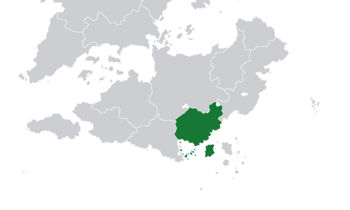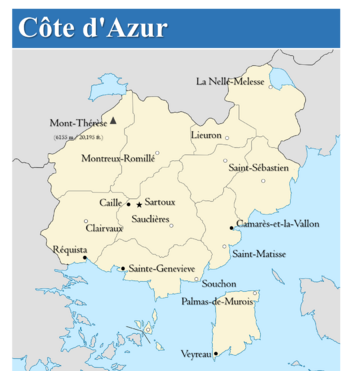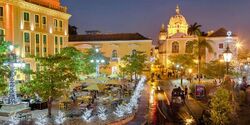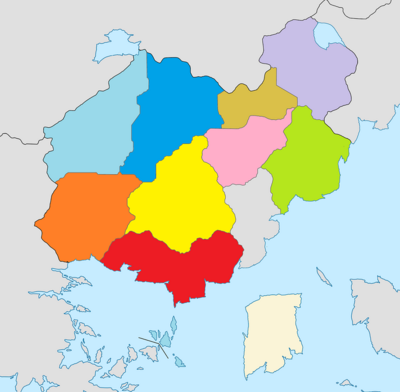Azure Coast
The Azure Coast République Souveraine de la Côte d'Azur | |
|---|---|
| Motto: Terre du Peuple de la Sainte Mère. | |
| Anthem: Bannière de la Découverte | |
 The Location of the Azure Coast in Asteria Inferior. | |
 The Administrative Divisions of the Azure Coast. | |
| Capital | Sartoux |
| Largest city | Sainte-Genevieve |
| Official languages | Gaullican |
| Ethnic groups | |
| Demonym(s) | Azuric Azurenne |
| Government | Federal Constitutional Parliamentary Republic |
• President | Rémy Soyer |
• Premier | Céleste Auberjonois |
| Legislature | Le Grand Conseil |
| History | |
• Colonial Era | 1560-1934 CE |
• Independence | 1934-1937 CE |
• Azuric Civil War | 1937-1947 CE |
• Military Rule | 1947-1973 CE |
• Blue Revolution | 1973-1975 CE |
• New Republic | 1975 CE-Present |
| Area | |
• Total | 1,042,343.68 km2 (402,451.14 sq mi) |
| Population | |
• 2020 census | 22,575,970 |
• Density | 21.65/km2 (56.1/sq mi) |
| GDP (PPP) | 2020 estimate |
• Total | $458.29 Billion |
• Per capita | $20,300 |
| GDP (nominal) | 2020 estimate |
• Total | $229.14 Billion |
• Per capita | $10,150 |
| Currency | Azuric Coronat (Ꞓ) (CZC) |
| Date format | mm-dd-yy |
| Driving side | right |
The Azure Coast, formally known as the Sovereign Republic of the Azure Coast (Gaullican; République Souverain de la Côte d'Azur), sometimes known by its Gaullican shortform Côte d'Azur is a sovereign country and federal constitutional parliamentary republic located in southern Asteria Inferior. A former colony of Gaullica, the Azure Coast is bordered to its north across the Southern Asterian Range by Satucin, and to its west by Belmonte. The national population of just over 22.5 million are unevenly clustered around the verdant coastal regions; the more isolated interior see a fraction of the coastal plain's population density. A developing economy and middle power on the continent, its capital city is Sartoux, while its largest city, busiest port and central economic and financial center is Sainte-Genevieve.
Human presence along the southern front of the Southern Asterian Range dates back roughly 50,000 years; nomadic hunter-gatherers were the first to arrive, likely from the north through the Sythes-Juoda Basin along game trails through to the mountain passes. The Tupi and Guarani peoples, moving east from present-day Belmonte are thought to have pushed the nomadic Kawésqar and Yahgan peoples further east into grounds less amenable for foraging but ripe for hunting. The coincidence of the development of agriculture and the first permanent settlements around 10,000 years ago would establish the basis for aboriginal Azurenne presence until the arrival of explorers from the Gaullican Empire under Joseph de Salers in 1560 CE. Initially seeking to circumnavigate Asteria Inferior and fine a safer route through to the other side of the mountains, Gaullican presence would only increase following the discovery of diamonds near present-day Sainte-Matisse. The first permanent settlement was founded by the colony’s first governor, Étienne Montluçon on the River Thauvin, near the modern-day city of Souchon (he would also go on to found a trade station and depot further upriver named Rendezvous, the present Sartoux.
The proselytization of the country over the ensuing 300 years established fervent love for the Gaullican homeland among the colony’s Euclean populations, though the native population and those of mixed ancestry remained less friendly. Independence came as a consequence of the Great War, when the colony was forcibly excised from Gaullica’s control in 1934. The Azurenne Civil War (1937-1947) that followed would see the rise of the councilist-socialist Vague Rouge face off against conservative Catholics and those seeking to build a modern republic, eventually commanded by Alban Serreau. The victory of the pro-democratic forces under Serreau drove the Vague Rouge survivors into the far north, where they would continue to launch an insurgency with guerrilla tactics for the next several decades. The failure of the 1950 Constitutional Convention to draft a new government led Serreau and his remaining military forces to seize the capital . For the next 23 years, Serreau would reign as a military dictator over the country, imposing his will until students and laborers rose up in protest, driving him from office into exile in the 1973 Blue Revolution. The new constitution for Côte d'Azur was approved in 1976, with the first free elections in the country’s history held in October of that year.
The Azure Coast is a developing economy with a rising HDI and declining poverty rate. The country has begun to engage in a modernization effort to restructure colonial infrastructure to better suit the new economic sectors such as petroleum extraction and refinement, precious minerals and commercial agriculture, including widespread wine and liquor production. Since the Blue Revolution in 1973, a growing services economy has begun to bring increasing wealth to the people, growing apace with a small but burgeoning technology industry. Tourism and gambling has become a major part of the economy along the southern and southwestern coastal areas, the Grand Strand. However, a significant income gap has led to rising inequality between the wealthy coast and the poorer interior; lesser infrastructure in the interior has also played a major role in slowing economic development of the country’s natural resources.
Largely isolationist from Asteria Inferior and global politics since the end of the Great War, Côte d'Azur has mostly shied away from participation in multinational organizations; it is however a member of the Asteria Inferior Common Market (ASTCOM). Following the election of its first female premier in 2021, the country has began exploring its role in the greater region and abroad.
Etymology
The name of the Republic dates to the mid-16th century from the Gaullican explorers who first landed there, near what is present day Veyreau on the Grand Strand. Côte d'Azur appears in the journal of Gaullican Captain Joseph de Salers in an undated May entry, describing the azure waters in contrast to the green of the heavy tropical foliage beyond the high tide mark. It also appears in a report submitted by Étienne Montluçon, the founder of the first permanent settlement in the new colony and its first Governor-General – Montluçon also describes the stark beauty of the country’s unspoiled beachscapes, thinking them “a deceptive lure” that tricked people into the much harsher interior with its beauty.
The different indigenous peoples native to the region where the modern country is located had several different names, some of which are still used today by their ancestors. The Tupi and Guarani both referred to the country as Jaguatul, or the Cliffs of the Jaguars, a nod to the Azurenne Catamount which once thrived in the region. The Kawésqar and Yahgán peoples further east differed from their western counterparts; the nomadic Kawésqar had no name for the land, moving about the high steppe and plains to the immediate east and southeast of the South Asterian Range. The Yahgán are the only group to mention anything about the coast itself, calling the region Pairohni, the Land of Clear Waters.
Though some circumstantial evidence exists to support the claim that the names of the indigenous peoples for the region were used officially by the first settlers, most historians agree that the name first kept for official records by the Gaullicans was Terre du Sud, the Southland. Over time, the descriptive “Azure Coast” began to replace this name, until official colonial documents signified the officialization of it as the new name in April 1654 CE. It has remained the name of the country, through its colonial ownership into independence and the present with the support of indigenous peoples who feel the name honors the characteristics of their ancestral homeland.
Geography
Topography
Biodiversity
Fauna and Flora
Climate and Weather
History
The Interbellum Period: A Tattered Nation Divided
Though many in the colonial government believed that their capitulation in the war would lead to a return to the status quote antebellum, those hopes were dashed when Côte d'Azur was extricated from Gaullica’s control by the Grand Alliance on July 18, 1934. A provisional government was established by the occupying powers in the captured capital of Sartoux, with representatives from the eleven Comtés meeting just south of the city in Pueyrredón to hammer out a new agreement on governance. Immediately, divisions in the façade of the new peace began to emerge between representatives from the eastern and northern Comtés (who were being influenced by heavy Councilist representation) and those from the southern and western Comtés where those more amenable to the former colonial rule were present. The southern-western bloc was in and of itself split in its dynamics, with conservative Solarian Catholics more likely to support the establishment of a new monarchy in Côte d'Azur, while other moderate conservatives and social democrats advocated for the establishment of a liberal democracy.
With the Great War coming to a close elsewhere in the world, diplomats converged on Veyreau in Sarazen to convene a Constitutional Convention to establish a new government. A local justiciar, Hugo Dufresne was selected by the representatives to serve as the Convention’s president, thinking him to be an impartial arbitrator in the disputes that were expected to arise. From the start, the extreme divide between the Councilist representatives from the more agrarian regions of the country, the pro-monarchy Catholics and the republicans from the cosmopolitan southwest caused immediate dissension, with little accomplished during the first session. A second attempt at establishing the Convention in Navarre in 1935 accomplished little more than the first, and both sides recognized that the inevitability of war seemed assured.
Sporadic episodes of civil unrest were plaguing the negotiations; the war in Côte d'Azur had been particularly destructive, and with the slow withdrawal of Grand Alliance forces from the country beginning in earnest in 1936, transitory inflation had begun to spiral out of control. Bread lines and shortages in the stores were compounded by the former colony’s lack of infrastructure, with most of their energy and transportation networks focused on driving materiel goods and wealth out of the country rather than around it. During the 1936 session, a last ditch effort to stave off civil war emerged in the form of a two-state solution, whereby the Councilists would control the northern and eastern Comtés of Antaya, Baudhuin, Navarre and Tananarive; meanwhile, Bonne, Casavant, Lehideux and Masseau would be placed under the provisional control of a new Congress which would settle the lingering disputes between the monarchists and republicans. The new arrangement ran into two major sticking points: in the agreement, the Comté of Auvray-LaClair was to be ceded to the monarchist-republican coalition, while the island Comté of Sarazen was to be ceded to the Councilists. However, a majority of the population in Auvray-LaClair was amenable to Councilist rule, while Sarazen was almost exclusively in the camp of establishing a liberal democratic government. Councilist representatives demanded Auvray-LaClair and half of Sarazen be ceded to their control; fearing the ramifications of being cutoff from fellow Gaullican-speaking Satucin in the north, the monarchist-republican coalition rebuffed them, and talks broke down for the final time.
The Azurenne Civil War (1937-1947)
In May 1937, the third attempt at drafting a national constitution was scheduled in Saint-Sébastien. With foreign troops now vacated from Azurenne soil, the Councilist Vague Rouge decided that the diplomatic pathway to power was no longer tenable. With rumors that the Vague Rouge was planning to stage a putsch on the provisional government, armed militias began to form in and around the site of the convention in the Comté de Antaya. As civilians began to rearm themselves, Vague Rouge leader César Mondragon decided the time was right to strike. With better equipment, better organization and an existing power structure left over from before the Great War, Mondragon and his chief field commander, General Alphonse Maitron led a successful raid on the Saint-Matisse armory, then marched unopposed towards Saint-Sébastien. Fearful over the reputation of the Vague Rouge from the war, many Catholic and pro-republican civilians began to evacuate Antaya, leading to massed confusion. Maitron and the Councilists took Lilleville on June 15, then made the final push into the shire capital beginning on June 25. A makeshift militia of former war veterans was hastily organized, leading to the first intensive fighting on June 26. The ensuing Battle of Saint-Sébastien would last only two days, with the Vague Rouge inflicting heavy casualties on the militia. Antaya was captured; thus begin the decade-long Azurenne Civil War.
Government
The system of government currently utilized by the Azure Coast was formulated in the aftermath of the Blue Revolution (1973-1976), when the autocratic military junta of dictator General Alban Serreau was overthrown after mass protests demanding liberal reforms to the economy and greater personal freedom. Because of its creators’ desire to appropriate greater civil rights for the country’s citizens, the national constitution – the Azéma Accords – is comprised of the functionality of the new government and a host of negative liberties to be observed by the state in support of the propagation of greater personal freedom and liberty for the individual. As far back as 1969, protest movements were already including new civil liberties and rights to be enshrined in the Azure Coast’s government. In 1972, political activist and writer Jean-Louis Pierrepont collaborated with professors at Gascoigne University to draft the Declaration of Delahoussaye, the formal document by which the new government drew inspiration from when crafting the legal rights of citizens and its structural composition. Copies of the Declaration are often included with printed copies of the Accords themselves as its foreward and preamble.
The Azure Coast is a constitutional federal parliamentary republic comprised of eleven districts known as Comtés (Shires), the federal capital district and one administrative territory in the extreme northwest of the country. Its national legislature, the Congrès des Conseillers (Congress of Councilors) currently seats one hundred delegates, distributed by population to the eleven comtés. Powers not enumerated to the federal government in Sartoux (or expressly prohibited throughout the hierarchy of governance) via the Congrès are delegated to the comtés via their governors, comté legislatures, and parish governments. Members of the legislature, the eponymous conseillers, stand for election every two years, with staggered elections established to ensure that veterancy will remain in the legislature at all times. The head of government, the Premier may serve a maximum of ten years and are chosen via their party to stand for the office. Conversely, the head of state, the President is directly elected by the people, with elections held once every five years (they are also capped at a maximum of ten years in office, or two full terms).
The powers of the president are largely relegated to ceremonial functions, generally diplomatic in nature. The president is responsible for representing the Azure Coast as its senior diplomat, and will engage with other foreign heads of state and dignitaries on behalf of the Congrès and the premier. They do however retain the ability to call snap elections in the event that a majority coalition in the Congrès dissolves, or if the premier resigns from office, is removed by the legislature, or otherwise dies or becomes incapacitated while serving. In comparison to the largely ceremonial role of the presidency, the premiership stands as the most powerful office in the Azure Coast; premiers are responsible for directly the policy platform of the majority coalition and decide which legislation the majority will bring forth during their term in office. The premier appoints members of the legislature to fill executive roles within the various ministries and further appoints a cabinet to assist them with policy and decision-making. The leader of the opposition also appoints legislators to fill various roles as part of the shadow government.
The Azurenne judiciary is an independent branch of the government, with the national Tribunal of the Republic serving as the apex of the legal system. Justices appointed to the tribunal are nominated and voted on via the legislature, and serve life terms in office at their leisure. The same process is carried out through the High Courts (courts that sit over multiple comtés) and the Federal Appellate Courts. Justices serving in all other civilian courts, be they Provincial Courts of the comtés or Parish Courts of the cities and counties stand for election, with individual administrative divisions setting term lengths and voting procedures for their respective polities.
In the 2021 General Election, the right-oriented Parti Conservateur, or PCR won the most seats with 46; they would form a majority coalition with the Solarian Catholic-founded Syndicat Catholique, or SYC, who won six seats. The social democrats and progressives of the Front de l'Unité Sociale, or FUS served as the head of the opposition, winning 39 seats; the remaining nine seats were won by two leftist groups allied to the FUS: the moderate Libérale (or PLB) with 6 seats and the hard-left Front de Socialiste Populaire (or FSP) winning 3 seats. The 52-48 split in the legislature is the smallest split seen in the legislature since the Social Unity Front’s single vote-split at the beginning of the 1996 term.
The 2021 election for the presidency was contested between PCR candidate and former minister of defense, Gen. (Ret.) Rémy Soyer and the FUS-backed governor of the Comté de Gabriela Giroux. Soyer won with 51.2% of the national vote; the 48.1% of the vote for Giroux was the best by a Social Unity Front candidate in more than twenty years. The 2021 presidential election was also unique in that it was the first in the history of the Azure Coast not to field a third (or fourth) candidate.
Administrative Divisions
| Map | Shire Name and Flag | Capital City | Population | Governor | |
|---|---|---|---|---|---|
| Shires of the Azure Coast | |||||
| Chateau Étrelles | 521,667 | Paul Desruisseaux (FUS) | |||
| Montreux-Romillé | 941,342 | Jean Esnault (PCR) | |||
| Lieuron | 341,342 | Henri LaBreque (FUS) | |||
| Souchon | 1,325,589 | Robert Arsenault (PCR) | |||
| Clairvaux | 969,662 | Parti Conservateur (PCR) | |||
| Sauclières | 1,033,428 | Toni LaMahieu (SYC) | |||
| Trévérien | 663,485 | Andre Sartre (FUS) | |||
| Saint-Sébastien | 486,515 | Tomas Vigier (FUS) | |||
| Camarès-et-la-Vallon | 857,223 | Emile Tisseur (PCR) | |||
| Palmas-d'Murois | 978,996 | Etienne Pieriot (PCR) | |||
| La Nellé-Melesse | 256,774 | Peter Roy (FUS) | |||
| Federal Territories of the Azure Coast | |||||
| Citadelle Vipère | 138,512 | Col. John Devereaux (ADF) | |||
Foreign Relations
Military
National Symbols
Economy
Since the Blue Revolution in 1973 and the rise of the new federal parliamentary republic in 1976, the Côte d'Azur economy has typically been classified as a free market capitalist state adhering to laissez-faire attitudes regarding business practices, environmental considerations and labor relations. A largely resource-driven economy owing to its rich mineral fields and petroleum operation in Masseau for much of its history as an independent state, the Azure Coast has recently seen a dramatic economic shift in its development. The coastal plain regions from Camarès-et-la-Vallon in the east to Réquista in the west, collectively known as the Grand Strand economic zone, has begun shifting towards a high-income services economy, with massive amounts of capital generated from the region’s gambling, tourism and financial sectors. The economic growth in the west outpaces that in the east by 10:1, leading to large wealth gaps between the two spheres, which further leads to higher or lower quality of living respectively. Much of the east’s economic potential remains locked away in inaccessible regions of the Azurenne High Steppe and the Southern Asterian Range due to the country’s colonial history and an infrastructure overlay deigned to remove wealth rather than create wealth. Infrastructure projects designed to spur agriculture and manufacturing in the east are a significant part of the country’s 2050 Economic Development Outlook Plan.
With the dominant party subscribing to a minimalist policy with respect to business and commerce, no central bank currently existed. Prior to the 2015-2017 Stagflation Crisis, federal deposits would be dispersed into the eleven central banks of its Shires. Following the economic policy of fiscal non-interventionists like Andi Blanchard and Jean-Louis Laurent, the country’s scarce regulations led to rapid industrialization and economic growth between 1989 and 2004 – the so-called “Azurenne Quarter”. The inability of the Shire banks to cooperate on economic policy in the event of a slow-down in growth meant that the federal government in Sartoux had very little ability to manage a significant economic crisis, as the 2015-2017 crisis demonstrated. Since 2017, plans have been discussed over chartering a new central bank, with current Premier (as of 2022) Céleste Auberjonois initiating a brand new platform for the PCR which includes chartering a central reserve to help govern monetary policy with the Template:Wp:.
Agriculture
Since its inception as a colony of the Gaullican Empire, Côte d'Azur’s primary economic resource has been its bountiful agricultural production. As early as the late-16th century, shipments of preserved Azurenne fruits were being shipped north through narrow mountain passes into Sythes for transport to ports along the northern coast of Asteria Inferior. Throughout its colonial period, the country’s ubiquitous plantations produced considerable crop yields for the Gaullican parent nation, including maize, plantains, rice, and wheat. As colonial expansion into the eastern plains commenced following the Harrowing Wars in the 18th century, animal husbandry began to appear via the introduction of cattle and sheep, with Azurenne dairy products becoming a particular staple industry in the east. Modern Côte d'Azur has continued to embrace its agrarian heritage through its Terres Éthérée Initiative, a national movement to establish ecologically sustainable agriculture on a commercial scale for the country’s farmers. Cocoa and coffee, indigo, tea and tobacco are popular cash crops that grow well in the nitrate-rich soils along the southern face of the Southern Asterian Range, while traditional staple crops like barley, maize, rapeseed and wheat continue to be ubiquitous in the transitional range from the tidal lowlands and the foothills to the Obsidians and the Skybreakers. A growing aquaculture industry has emerged in the 21st century in keeping with the country’s ecological sustainability projects: algae for biofuels, kelp and the nation’s coastal fisheries have experienced a major economic boom since the 2010s.
Minerals
Petroleum
Tourism
Geography
Climate
Biodiversity
Flora and Fauna
Topography
Demographics
Urbanization
Largest cities or towns in Azure Coast
Bureau National du Recensement (BNR) | |||||||||
|---|---|---|---|---|---|---|---|---|---|
| Rank | Comté | Pop. | Rank | Comté | Pop. | ||||
 Sainte-Genevieve  Caille |
1 | Sainte-Genevieve | Bonne | 3,972,631 | 11 | Chateau Étrelles | Antaya | 521,667 |  Réquista  Souchon |
| 2 | Caille | Lehideux | 2,787,692 | 12 | Saint-Sébastien | Navarre | 486,515 | ||
| 3 | Réquista | Casavant | 1,519,231 | 13 | Lieuron | Baudhuin | 341,342 | ||
| 4 | Souchon | Bonne | 1,325,589 | 14 | La Nellé-Melesse | Tananarive | 256,774 | ||
| 5 | Sauclières | Lehideux | 1,033,428 | 15 | Sartoux | District Fédérale Paroisse | 237,193 | ||
| 6 | Palmas-d'Murois | Sarazen | 978,996 | 16 | Sainte-Yvonne | Ponthieux | 120,519 | ||
| 7 | Clairvaux | Casavant | 969,662 | 17 | Sardoul | Sarazen | 92,981 | ||
| 8 | Camarès-et-la-Vallon | Ponthieux | 857,223 | 18 | Quinnett | Antaya | 82,526 | ||
| 9 | Trévérien | Masseau | 663,485 | 19 | Barrault | Baudhuin | 78,231 | ||
| 10 | Montreux-Romillé | Auvray-LaClair | 541,342 | 20 | Alaphilippe | Auvray-LaClair | 68,432 | ||
Ancestry and Ethnicity
Religion
Languages
Education
Health
Infrastructure
Transport
Telecommunications
Energy
Culture
Owing to its geographic isolation from its larger neighbors to the north, the cultural development of Côte d'Azur has been heavily fueled by its native population, with influence from the Gaullican colonials keeping apace, though at a lessened level than in comparable colonies from the same era. As early as the 17th century Gaullican colonists had begun incorporating elements of native clothing and culinary arts into their own traditions from the Gaullican homeland – and from other Gaullican colonies. As connectivity with Belmonte, Satucin and the international community broadened through improved travel across the Southern Asterian Range and abroad beginning in the 19th century, the cultural homogenization of these new influences created a veritable melting pot in Côte d'Azur, establishing the basis for the modern culture as it exists today. Today, the country has established a unique national identity from its peers thanks to this commixture of influences, serving as a burgeoning launching point for popular trends in dance, dress, music and sport in Asteria Inferior and beyond.




